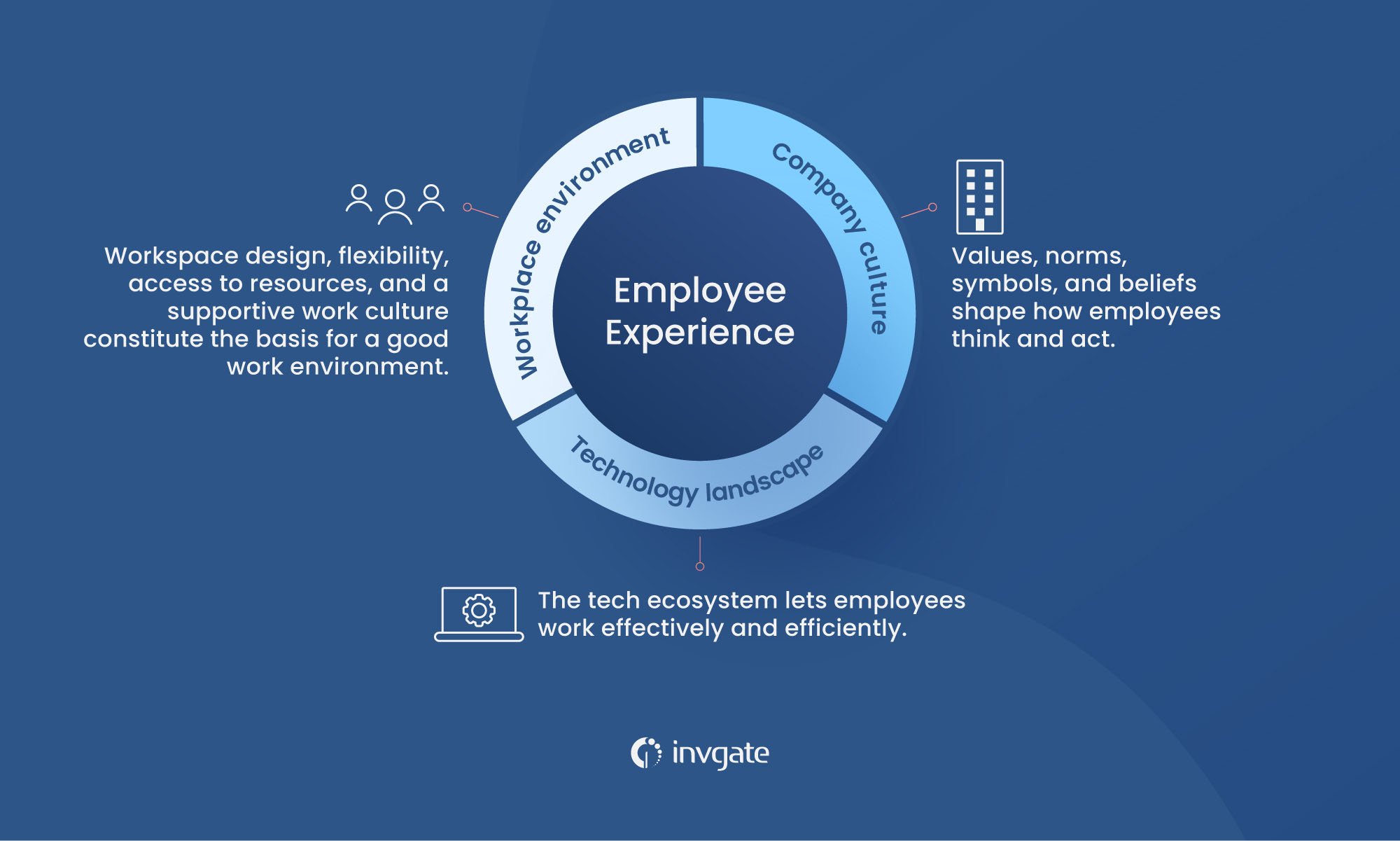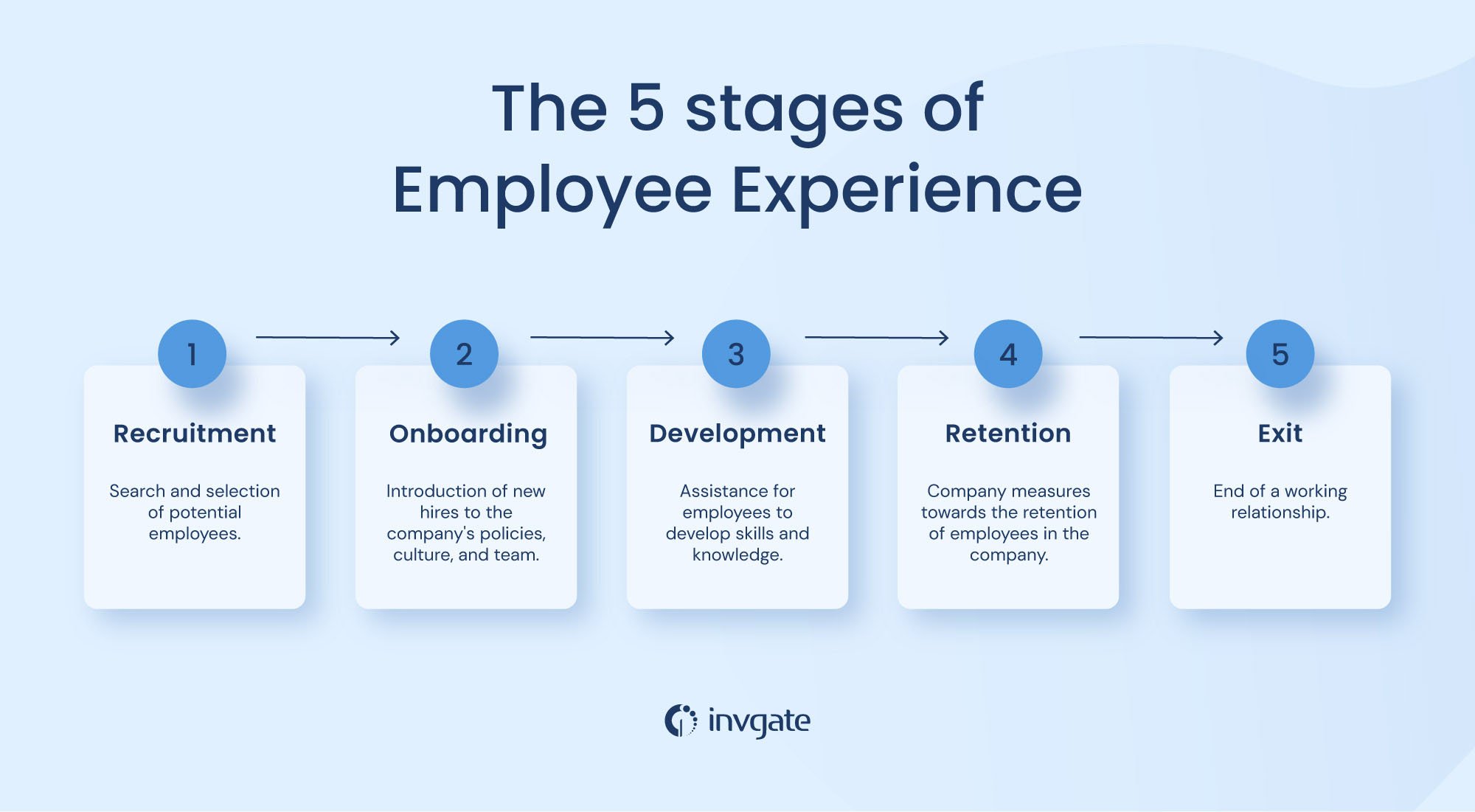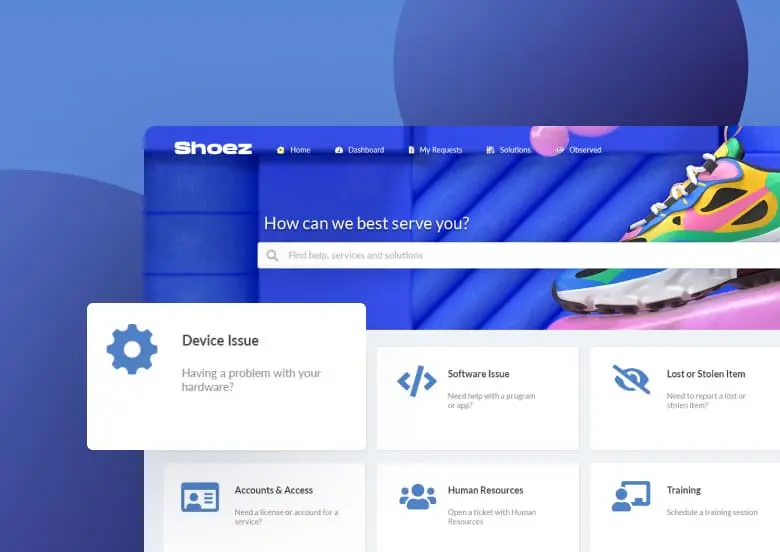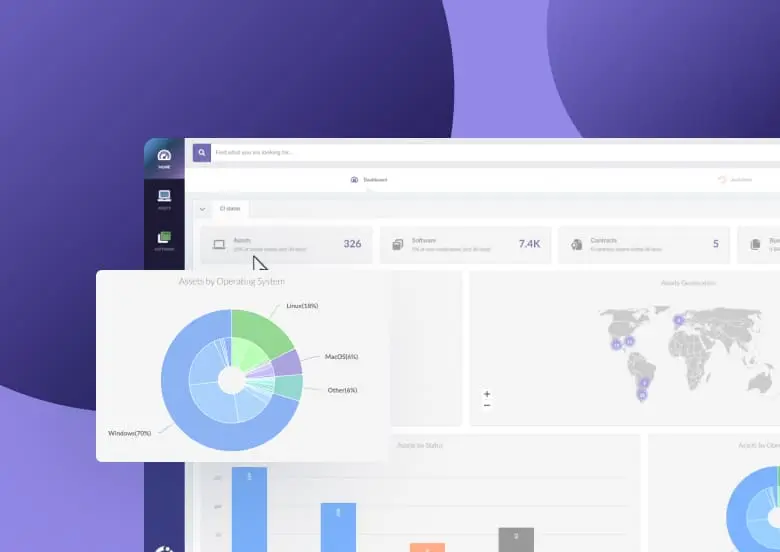When we talk about Experience Management, we mean using data collected from customer interactions to understand their experiences with your business comprehensively. However, we tend to associate customers with an organization's end-users, leaving out another company touchpoint that should be cared for: employee experience (EX).
Employee experience is relevant for any organization, especially if you implement it as part of a people-first work culture since it directly affects your IT support team's performance, productivity, and engagement.
In this article, you'll find everything you need to know to improve your company's employee experience, including:
- What employee experience is and why it's relevant.
- The different ways to collect employee experience data and use it to everyone's benefit.
- Strategies and challenges when improving your employees' experience.
Let's begin!
What is employee experience?
Employee experience is a holistic approach to managing and improving the employee journey, from recruitment to retirement. It encompasses all the activities, processes, and interactions employees have with their employers throughout their employment.
It involves everything from onboarding and training to recognition and rewards, as well as how employees feel about their job, workplace, and offboarding process. Employee experience is essential for organizations looking to attract, retain, and engage top talent.
It's pretty much based on the idea that employees should have a positive and engaging experience throughout their employment lifecycle to be productive and satisfied with their job. With this in mind, there are a couple of basic things you can do, such as:
- Creating a workplace environment that values employees as individuals.
- Provide meaningful work opportunities.
- Offer clear communication channels.
- Encourage collaboration.
- Provide access to resources needed for success.
Employee engagement vs. employee experience
Employee engagement and employee experience are two essential concepts in today's workplace. Both involve understanding and addressing the needs of employees, but they differ in focus.
- Employee engagement is dedicated to boosting employees'
motivation and job satisfaction. - Employee experience is focused on providing a positive work environment that encourages productivity.
Employee engagement involves creating a work atmosphere where employees feel motivated to perform their best. This includes providing recognition for good performance (something you can easily do with InvGate Service Management's gamification features), offering rewards for reaching goals, and encouraging collaboration among team members.
On the other hand, employee experience has to do with creating an environment where employees can thrive. This entails providing adequate resources, offering flexible working arrangements, and ensuring employees have access to professional development opportunities.
Why is employee experience important?
Employee experience has become a core component of any successful business strategy. Companies realize that providing a good employee experience can have numerous benefits, such as:
- Improved morale and motivation.
- Increased job satisfaction.
- Higher productivity levels.
- Enhanced collaboration between teams.
- Increased innovation and creativity.
- Improved customer service.
- Reduced absenteeism and turnover rates.
- Enhanced recruitment processes.
- Improved employer branding.
- Greater financial returns for the organization.
The 3 areas of employee experience
Improving EX requires changes in the company culture, technology landscape, and workplace environment. These three areas of employee experience need to be aligned to create a positive atmosphere for everyone in the organization.

1. Company culture
A company's culture is the atmosphere created by its shared values, beliefs, and behaviors. It is the organization's personality, and the result of the combined values, norms, symbols, and beliefs that shape the way employees think and act.
A company's culture influences how it interacts with its customers, suppliers, and other stakeholders. It also affects the decisions made and the organization's overall success. A positive company culture is essential for employee satisfaction, productivity, and loyalty.
2. Technology landscape
The technology landscape for employee experience is rapidly changing and evolving. Companies are looking for the latest digital trends to create an environment that is more engaging, productive, and efficient while also providing a better user experience.
Technology can help by creating a flexible and seamless experience. Its ecosystems are becoming highly complex, with sophisticated tools being developed and adopted at an accelerated pace. These tools work best together when businesses empower employees with self-service discovery tools that give them the power to integrate the technology of choice into their workflows.
The next generation of workplace technologies will provide greater efficiencies and innovation in business processes to better serve customers.
3. Workplace environment
The work environment has a huge impact on employee experience. A good workplace environment includes ergonomically designed workspaces, flexible working arrangements, access to technology, education, and training resources, and open communication with colleagues and supervisors. Additionally, it is about offering a supportive work culture that encourages collaboration and camaraderie.
Diversity and inclusion are two other vital factors that contribute to employee experience and a healthy company culture for employees. The importance of an inclusive work environment cannot be overstated. Not only does it benefit employees with diverse backgrounds, but it also contributes to the success of the business.
In summary, company culture is about creating a positive work atmosphere that encourages collaboration and innovation. The technology landscape is about ensuring that the right tools are in place for employees to do their jobs effectively. And workplace environment is about creating a physical space in which employees can enjoy and be productive.
The 5 stages of employee experience
We already mentioned that EX is a holistic process involving an employee's whole journey during their stay at a company. And this can easily be seen if we look at the five stages of employee experience. Each of them is critical in providing a positive employee lifecycle.

1. Recruitment
This stage involves the process of sourcing and selecting potential employees who are suitable for the role. It is important to ensure that the chosen candidates fit into the organizational culture and values.
2. Onboarding
Once suitable candidates have been recruited, employee onboarding is the next step. This involves introducing a new hire to the company's policies, culture, and team so they can hit the ground running.

3. Development
This stage is about helping employees develop the skills and knowledge necessary to succeed in their current roles and beyond. This can include providing employees access to learning and development opportunities, such as mentorship programs, online courses, and workplace training.
4. Retention
Retention is the process of retaining employees and ensuring they stay with your company. It involves measuring employee satisfaction, increasing engagement and loyalty through continuous employee development, and identifying areas for improvement.
5. Exit
The final stage of an effective employee experience, exit, is the natural end of a working relationship. At this point, offboarding should be done promptly so employees can succeed in their next role.
The stages above are not linear; each step has multiple attributes that must be prioritized. For example, onboarding might have "positive culture" as one attribute, but it may also have "engagement" as an attribute.
How to improve the employee experience
1. Offer competitive salaries and benefits
Competitive salaries and benefits are an integral part of the employee experience. Employees need to feel that their work is valued and their employers are willing to invest in them. Doing so can help create a positive atmosphere and encourage employees to stay with your company.
2. Focus on employee development and personal growth
Too often, employers need to consider their employees' needs before focusing on their business's immediate needs. Focusing on employee development and personal growth can help create a positive company culture that benefits businesses. This can be achieved by offering employees training and educational opportunities and providing paid time off for education-related activities.
3. Provide work-life balance for both employees and employers
Employees need to feel that their employer is willing to invest in them outside of work, too; this is another reason why it's important to offer competitive pay.
4. Offer generous policies, such as paid sick days and vacation time
Paid sick days and vacation time are the two most important things to a person's health because they provide mental health benefits and avoid burnout, which can benefit employees and the company.
5. Help employees advance their careers
Training or flexible schedules can help individuals move forward in their career paths by providing opportunities for learning new skill sets or taking care of personal issues during work hours. Much like company benefits, these programs can increase engagement and retention.
6. Invite employees to participate in social activities
The desire to belong and be a part of something bigger is a powerful motivator for many people. If your company offers opportunities for team building or social outings, it can help retain talent that might otherwise be looking for other work options.
7. Leverage technology
Technology can be used to improve the employee experience. We already mentioned the tech stack your company can offer to enhance your workers' daily activities. But you also need a technology backbone to support your employees in the best possible way.
And that's what InvGate Service Management can do for you. With it, you can:
- Channel your employee queries and issues quickly, seamlessly, and from multiple communication channels.
- Keep track of tickets from all areas (not just IT but also HR, Finances, Maintenance, and more) and oversee their resolution.
- Automate processes to ensure that no step is missed, every employee receives the same treatment, and no time is wasted on repetitive tasks.
- Measure your teams' performance to spot improvement opportunities.
With its quick implementation, intuitive UX, and drag-and-drop features, your whole company will be submitting and handling requests in no time. Plus, its self-service capabilities will reduce the number of tickets significantly by providing employees with a knowledge base, self-service portal, and service catalog to solve basic questions by themselves.
8. Create a clear hybrid work policy
Creating a clear hybrid work policy tailored to your organization's needs is essential for setting expectations and ensuring everyone is on the same page. In fact, remote work is proven to be here to stay. So, your policy should be comprehensive and cover topics such as working hours, communication expectations, technology requirements, and guidelines for meetings, collaboration, and time off.
Hence, allow employees to choose the hours that work best for them, whether that means working a traditional 9-to-5, splitting their day between home and the office, or some other combination. This will give them more control over their workday, help them better manage their own schedules, and impact their co-workers' schedules.
9. Prioritize the digital employee experience (DEX)
Establishing a digital employee experience strategy helps transform your business into a people-oriented IT enterprise. It can drastically enhance employee engagement and streamline the company's operations to make it more agile.
DEX is key for any IT company that wants to create a workplace culture of innovation and collaboration. By implementing such strategies, companies can better engage their employees, foster a sense of belonging, and make meaningful connections with their workers.
|
|
"For far too long, technology has been seen as the most important thing, not the experience of those consuming that technology. That's what we need to shift. That's really where we can make a difference." Jon Leighton |
So there you have it, flexible hours, opportunities for advancement, and involvement in social activities are just a few motivating factors that can help spark employee loyalty. All these things combined can make your company an exciting place to work – but if you're going to offer them, make sure they're done right!
Measuring employee experience
Improving Employee Experience is a challenge in itself, but it falls short if you don't measure it. Measuring EX is essential to gauge the success of any measures implemented. A good approach is to regularly conduct surveys with employees to assess their satisfaction, engagement, and overall well-being.
When doing so, make sure to monitor the following key performance indicators (KPIs):
- Employee Retention Rate: The percentage of employees who remain with the company after one year. This metric indicates how satisfied and engaged employees, employers, and customers are with the company.
- Employee Referral Rate: The percentage of new hires who existing employees refer. A high referral rate suggests that current employees are willing to recommend the company to others, which indicates a good employee experience.
- Employee Survey Results: Surveys can provide valuable insights into employees' feelings about their job and the company culture. Surveying employees regularly can help identify areas where the company can improve and growth opportunities.
- HR Scorecard: This tool aggregates data from other sources about the company's strengths, weaknesses, and opportunities for improvement. It helps organizations identify their strengths and target areas where they can improve their performance.
- 360-degree surveys: Another type of operational survey that employee experience professionals can use is a 360-degree survey. It focuses on asking respondents about their opinions in areas such as personal values, work-life balance, and leadership style, among others.
- Satisfaction surveys: Satisfaction surveys are a type of operational survey with a primary focus on employee experience. They are often used to measure the customer experience and offer some insight into what employees value.
Employee experience challenges
This article wouldn't be a guide without addressing the potential challenges you can face when working on a Employee Experience strategy. The key here is to have them in mind to come up with solutions before they become a problem.
- Communication issues - Employee experience can be impacted by a lack of communication or an inability to communicate effectively within the organization. This can lead to employees feeling disengaged, confused, and disconnected from their work and the organization as a whole.
- Lack of engagement - Employees can become disengaged from their job if they feel there's a lack of recognition or appreciation for their work. This can lead to a decrease in productivity and an overall feeling of dissatisfaction.
- Unclear expectations - When employees don't know what's expected of them, they may be unsure of how to complete their tasks or how to progress in their roles. It means that the employee doesn't have a clear understanding of what their job entails, what the goals of the job are, or how their performance is being evaluated. This can lead to confusion and frustration, as the employee is not sure what they are supposed to be doing or how they should measure their success.
- Poorly designed processes - Bad processes can cause confusion and inefficiency, leading to poor employee experience. To improve employee experience, companies should take the time to review, streamline, and optimize their processes to ensure that they are efficient and easy for employees to understand.
- Unproductive feedback - Feedback that does not help an employee improve their performance or address the challenges they are facing is helpless. It can be negative and judgmental, and may even seek to undermine the employee's confidence or morale. Examples of unproductive feedback include criticism that is not constructive, overly personal comments, or feedback that focuses on an employee's mistakes without offering any solutions.
- Poor team dynamics - Poor team dynamics can lead to a feeling of conflict and tension, which can cause morale to decrease. They may have occurred when a leader was not clear in their expectations of the team members. For example, the leader might have said that they wanted everyone to work closely together but were not clear about how close this should be; or when there was little or no discussion about goals for the project.
- Leadership issues - There are times when the leadership can create a toxic work environment or make employees feel undervalued or less important than they are, which could lead to lower levels of productivity and engagement.
- Not offering personalized support - Offering personalized support to employees is a powerful way to improve their overall work experience. By proactively engaging with each individual, employers can ensure that their employees feel valued and heard. This helps create an environment of positive collaboration and respect while also preventing any negative situations from arising due to a lack of communication or understanding.
- Lack of autonomy - Employees may not be allowed the freedom to complete their tasks without supervision or put in place barriers that limit their ability to do so, leading them to be frustrated and disengaged from their jobs.
In conclusion
Companies are looking for ways to improve the employee experience as the competition for top talent increases. And it is about more than just providing a comfortable workspace and good benefits. It's about creating an engaging, supportive, and inspiring environment for employees to thrive.
Implementing employee experience as a part of a people-first culture is a key factor in driving growth and retention when the great resignation phenomenon is challenging companies to do better. For that reason, companies that invest in creating an enjoyable work environment will be able to attract and retain the best talent, while those that don't will struggle to compete.
In this context, IT teams are often the unsung heroes of the workplace. They are responsible for keeping systems running and making sure all technology needs are taken care of. But they are also the ones that might have the exact information you need to begin with a change in EX.
So, take the time to listen to their feedback, understand their goals, and show appreciation for their work to start building an environment where your employees feel valued and appreciated.
















